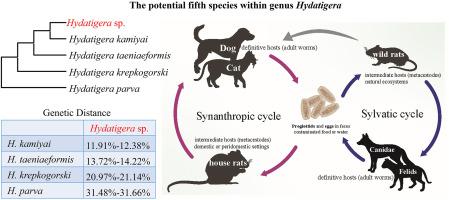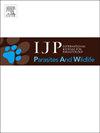广东省啮齿动物带绦虫属潜在第五种的分子鉴定
IF 2.2
3区 医学
Q3 ECOLOGY
International Journal for Parasitology-Parasites and Wildlife
Pub Date : 2025-08-05
DOI:10.1016/j.ijppaw.2025.101126
引用次数: 0
摘要
根据分子数据,带甲是最近复活的一个属,仅包括4个有效种:带甲带甲、krepkogorski带甲带甲、parva带甲带甲带甲带甲。本研究共采集鼠类479只。2023年在广东省3个地点采集5种鼠类,共观察到46只肝脏可见囊肿。利用18S rRNA序列进行分子分析,发现46个肝囊肿中有38个被包虫虫感染,提示包虫虫属是引起可见肝囊肿的主要绦虫属。进一步利用新一代宏基因组测序(mNGS)获得这些绦虫的线粒体基因组。基于12个蛋白质编码基因(PCGs)和18S rRNA的系统发育分析均表明形成了两个不同的分支:一个包括带绦虫,另一个代表了一个新的分支,定位为神谷人的姐妹分支,显示12个PCGs的遗传距离为11.91% - 12.38%,18S rRNA的遗传距离为3.22% - 5.25%。考虑到较深的种间遗传距离,本研究发现的新分支可能是Hydatigera属的第五种,称为Hydatigera sp.。带绦虫和Hydatigera sp.不仅利用野生啮齿动物(N. huang, N. niviventer和R. andamanensis),而且还利用家鼠(R. norvegicus和R. tanezumi)作为中间寄主。这一发现表明,它们可能同时具有森林传播周期和共生传播周期,这引起了人们对它们对人类和家畜的潜在威胁的关注。本文章由计算机程序翻译,如有差异,请以英文原文为准。

Molecular identification of the potential fifth species within genus Hydatigera (Cestoda: Taeniidae) in rodents of Guangdong province, China
Hydatigera (Cestoda: Taeniidae) is a recently resurrected genus based on molecular data, comprising only four valid species: Hydatigera taeniaeformis, Hydatigera krepkogorski, Hydatigera parva, and Hydatigera kamiyai. In this study, a total of 479 rodents were collected. In total, 46 livers with visible cysts were observed from five species of rodents collected in three locations of Guangdong province, China, in 2023. Molecular analysis utilizing 18S rRNA sequences indicated that 38 of the 46 liver cysts were infected by Hydatigera, suggesting that this genus represents the predominant tapeworm responsible for the visible liver cysts in rodents. Metagenomic next-generation sequencing (mNGS) was further used to obtain the mitochondrial genomes of these tapeworms. Phylogenetic analyses based on the 12 protein-coding genes (PCGs) and 18S rRNA both demonstrated the formation of two distinct clades: one comprising H. taeniaeformis, and the other representing a novel clade that is positioned as the sister clade to H. kamiyai, exhibiting genetic distance of 11.91 %–12.38 % for the 12 PCGs and 3.22 %–5.25 % for the 18S rRNA. Given the deep inter-species genetic distance, the novel clade identified in this study may be the fifth species within the genus Hydatigera, designated as Hydatigera sp. Both H. taeniaeformis and Hydatigera sp. were found to utilize not only wild rodents (N. huang, N. niviventer and R. andamanensis) but also house rats (R. norvegicus and R. tanezumi) as intermediate hosts. This finding indicates that they may have both sylvatic and synanthropic transmission cycles, raising concerns regarding their potential threat to humans and domestic animals.
求助全文
通过发布文献求助,成功后即可免费获取论文全文。
去求助
来源期刊

International Journal for Parasitology-Parasites and Wildlife
Medicine-Infectious Diseases
CiteScore
3.80
自引率
5.60%
发文量
113
审稿时长
45 days
期刊介绍:
The International Journal for Parasitology: Parasites and Wildlife (IJP-PAW) publishes the results of original research on parasites of all wildlife, invertebrate and vertebrate. This includes free-ranging, wild populations, as well as captive wildlife, semi-domesticated species (e.g. reindeer) and farmed populations of recently domesticated or wild-captured species (e.g. cultured fishes). Articles on all aspects of wildlife parasitology are welcomed including taxonomy, biodiversity and distribution, ecology and epidemiology, population biology and host-parasite relationships. The impact of parasites on the health and conservation of wildlife is seen as an important area covered by the journal especially the potential role of environmental factors, for example climate. Also important to the journal is ''one health'' and the nature of interactions between wildlife, people and domestic animals, including disease emergence and zoonoses.
 求助内容:
求助内容: 应助结果提醒方式:
应助结果提醒方式:


